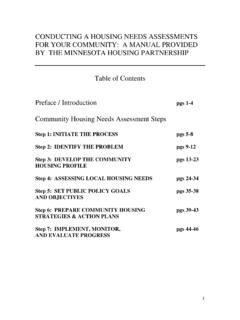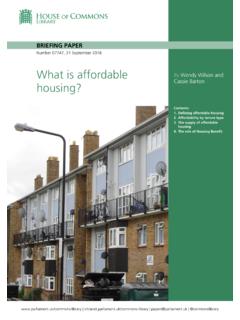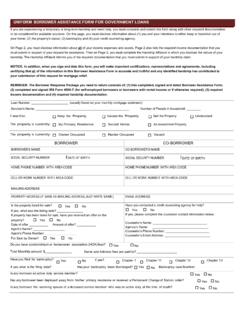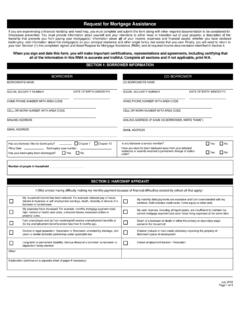Transcription of Setting rents for social housing - GOV.UK
1 OFFICIAL Setting rents for social housing Addendum to the Sector Risk Profile 2019 March 2020 Setting rents for social housing 1 Contents 1. Introduction 2 2. Executive summary 3 3. Background 5 Current requirements 5 Future requirements 6 4. Common issues that increase the risk of non-compliance 7 Changing requirements 7 Exceptions from rent requirements 8 Affordable Rent 9 Service charges 10 New rental products 11 Data quality 11 5. Considerations for providers if rents are non-compliant 12 6. Communicating non-compliance with rent or data quality requirements 13 Setting rents for social housing 2 1. Introduction This document is an addition to the Sector Risk Profile 2019,1 it supplements the section on rents and reiterates some of the themes set out in the addendum to the Sector Risk Profile 2018 on lease-based providers of specialised supported The note is primarily aimed at private registered providers (PRPs) of social housing but is also relevant to other stakeholders including local authority registered providers (LARPs) in preparation for the new Rent Standard which will take effect from 1 April 2020.
2 We are now in the final year of the rent reduction period under the Welfare Reform and Work Act 2016 and regulations made under it (WRWA). As we look back over our engagement over this period, and forward to the forthcoming Rent Standard, this addendum sets out the areas that are most likely to increase the risk of non-compliance with rent and data quality requirements. Boards and councillors must be assured that these risks are being effectively managed when rents for social housing are being set. The addendum also sets out what the sector can expect from the Regulator of social housing (RSH) with regard to regulation of rent requirements in future. 1 2 Setting rents for social housing 3 2. Executive summary From 1 April 2020, the vast majority of providers3 will have come to the end of the four-year requirement to reduce social housing rents as set out in the WRWA, and there will be a new Rent Standard4 in effect.
3 The Standard will apply to both PRPs and LARPs (unlike the Rent Standard in force prior to the commencement of the WRWA). As directed by government, the new Rent Standard is in line with the Ministry of housing , Communities and Local Government s (MHCLG) policy statement on rents for social Registered providers need to ensure that they understand the requirements and comply. The affordability of rents is one of the fundamental benefits of social housing and Setting social housing rents in line with requirements is an essential part of being a registered provider. Non-compliance with government policy is a serious issue. Failure to comply with government policy on rents undermines the value of social housing to individual tenants and taxpayers. It also risks damaging the reputation of individual providers and the sector as a whole. Further, since rent and service charge income accounts for the bulk of sector revenue, it is essential that charges are set appropriately to maintain the trust of stakeholders.
4 Finally, complying with regulatory and legal requirements is fundamental to good governance. Past engagement with PRPs on rents and our preparation for the new Rent Standard have highlighted a range of specific issues that increase the risk of non-compliance. These include: failure to take account of changing government policy and corresponding requirements in the provider s rent Setting policy and procedures, especially in relation to formula rent incorrectly treating properties as exempt or excepted from elements of rent rules incorrectly calculating or applying Affordable Rent incorrectly calculating or applying service charges in contravention of the Landlord and Tenant Act 1985 new, bespoke rental products with rents that do not comply with requirements poor quality data. 3 This depends on the date on which the relevant year under the WRWA commences (for a majority of providers this is 1 April).
5 Some providers will have a different relevant year, and they should be aware of this. 4 #economic-standards 5 Setting rents for social housing 4 The risk of non-compliance with rent requirements often stems from a failure to identify rent Setting as a strategic risk, as well as from weak internal controls. This results in inadequate assurance at board level that rents are set correctly. Boards and councillors should make sure they are satisfied that robust rent Setting controls are in place and should seek appropriate assurance that they are operating effectively. Most providers appear to set their rents appropriately. However, engagement with PRPs over recent years indicates there is scope for improvement. As a result, we are changing the way we communicate cases of non-compliance in relation to rents compliance and data quality. For both PRPs and LARPs, where we lack assurance in relation to the rent requirements or data quality (for PRPs this is likely to be across all data submissions, not just rents data) we may issue a regulatory notice outlining the nature of the For PRPs we will also consider how these issues affect our view of a provider s overall compliance with the Governance and Financial Viability Standard (this is no change from our current approach).
6 For PRPs with over 1,000 units of social housing , this may mean that we follow up a regulatory notice with a new or revised regulatory judgement which takes the identified rent or data quality issues into account. This approach will be implemented from 1 May this year. Information on our approach to issuing regulatory notices is contained in Regulating the Standards7. Rent rules can be complex but adhering to them is a fundamental part of being a registered provider of social housing . It is incumbent on boards and councillors to make sure that they have the required skills, or access to suitably qualified independent advice, so that they can take assurance that organisational internal controls around rent Setting are effective. 6 We will publish regulatory notices where this is consistent with our duty to exercise our functions in a way that minimises interference and is proportionate and consistent.
7 7 Setting rents for social housing 5 3. Background The control of rent levels and rental increases has long been a feature of the social housing sector, with specific requirements changing over time. Providers must ensure they fully understand and comply with the relevant requirements as these change. Rent and service charge income is the sector s core revenue stream; Setting them correctly is fundamental to financial viability. Adhering to all relevant law and complying with regulatory requirements are fundamental to good governance. Indeed, they are key elements of the Governance and Financial Viability Standard8 and PRP boards are required to certify compliance with the Standard in their annual accounts. We expect providers to have robust systems of internal control in place to ensure compliance with rent and service charge requirements. Such systems should be underpinned by high-quality data which providers can use to assure themselves, their tenants, and the regulator that rents are being charged appropriately.
8 Boards and councillors are responsible for ensuring that their organisations are compliant and should seek assurance that this is the case. Between 2015/16 and 2018/19 we engaged with PRPs in 84 cases because the data submitted in the Statistical Data Return (SDR)9 was of poor quality. Although we have seen some improvements over the last few years, there remains scope for further progress. This addendum highlights the areas where providers are most at risk of getting things wrong. Current requirements Since 2016/17, registered providers have been subject to legal requirements under the WRWA in relation to the rents they can charge. For most registered providers this has meant reducing rents by 1% each year, with exceptions set out in the regulations under the act. Service charges are governed by specific tenancy agreements and leases, as well as common law and statute in this area, including the Landlord and Tenant Act 1985, in which the definition of service charge , as distinct from rent , is linked to costs incurred ( for cleaning of communal areas, or grounds maintenance).
9 8 #economic-standards 9 Setting rents for social housing 6 Future requirements From 1 April 2020, a new Rent Standard will be in effect. The new rules applied by the rents Standard enable a maximum annual rental increase of Consumer Price Index (CPI) plus 1%. The Rent Standard will apply to both PRPs and LARPs, unlike the Rent Standard that predated the WRWA. It is important that all providers have a comprehensive understanding of the new rent rules and the impact that these will have on their organisation in advance of 1 April 2020. Service charges will continue to be governed by tenancy agreements and leases, as well as relevant common law and statute, including the Landlord and Tenant Act 1985. Setting rents for social housing 7 4. Common issues that increase the risk of non-compliance Engagement with PRPs on rent requirements has revealed a range of common issues that providers need to avoid when Setting rents .
10 These issues usually stem from a failure to identify rent Setting as a strategic risk and weak internal controls around rent Setting . Under our co-regulatory approach we operate as an assurance-based regulator, seeking assurance from providers as to compliance with requirements. On an annual basis, we identify providers which appear to be outliers based upon analysis of the rents data supplied in regulatory returns. We engage with these providers to seek assurance about their compliance with requirements. The onus is on these providers to demonstrate compliance. Where providers cannot supply the requisite assurance we may conclude a breach of standard and reflect this in the judgements and decisions that we reach. Governing bodies are responsible for ensuring that providers businesses are managed effectively and in line with regulatory and legal requirements. This includes rent compliance.















